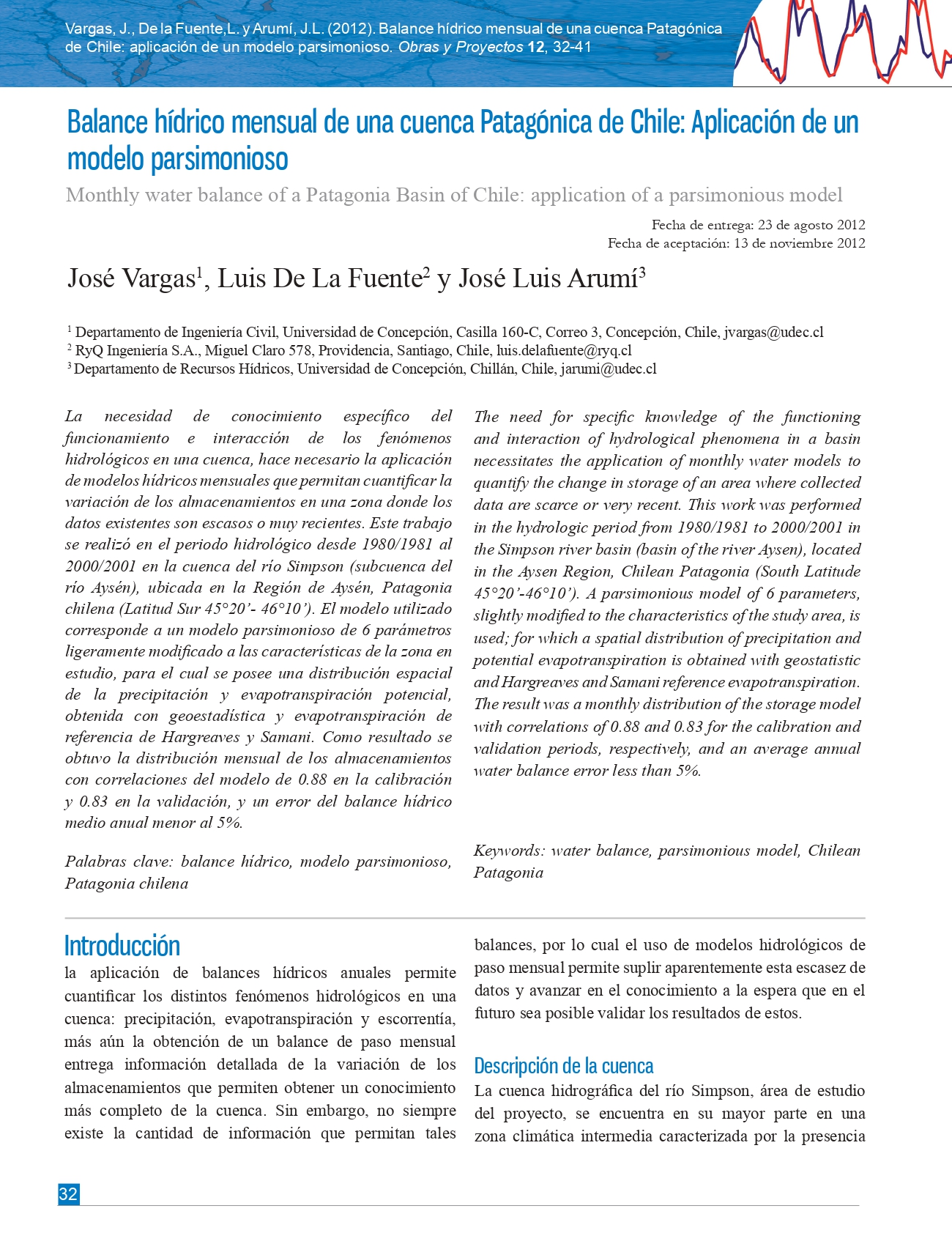Monthly water balance of a Patagonia Basin of Chile: application of a parsimonious model
DOI:
https://doi.org/10.4067/S0718-28132012000200003Keywords:
water balance, parsimonious model, Chilean PatagoniaAbstract
The need for specific knowledge of the functioning and interaction of hydrological phenomena in a basin necessitates the application of monthly water models to quantify the change in storage of an area where collected data are scarce or very recent. This work was performed in the hydrologic period from 1980/1981 to 2000/2001 in the Simpson river basin (basin of the river Aysen), located in the Aysen Region, Chilean Patagonia (South Latitude 45°20'-46°10'). A parsimonious model of 6parameters, slightly modified to the characteristics of the study area, is used; for which a spatial distribution of precipitation and potential evapotranspiration is obtained with geostatistic and Hargreaves and Samani reference evapotranspiration. The result was a monthly distribution of the storage model with correlations of 0.88 and 0.83 for the calibration and validation periods, respectively, and an average annual water balance error less than 5%.
References
CAZALAC (2004). Guía Metodológica para la elaboración del mapa de zonas áridas, semiáridas y subhúmedas secas de América Latina y el Caribe. Centro del Agua para Zonas Áridas y Semiáridas de América Latina y El Caribe (CAZALAC), 66p.
Coutu, S., Giudice, D.D., Rossi, L. and Barry, D.A. (2012). Parsimonious hydrological modeling of urban sewer and river catchments. Journal ofHydrology 464-465, 477-484. https://doi.org/10.1016/j.jhydrol.2012.07.039
DGA (1987). Balance Hídrico de Chile. Dirección General de Aguas. Ministerio de Obras Públicas. Chile.
DGA (2004). Cuenca del Río Aysén. Diagnóstico y clasificación de los cursos y cuerpos de agua según objetivos de calidad. Dirección General de Aguas. Ministerio de Obras Públicas. Chile. Realizado por CADE-IDEPE.
Hargreaves, G.H. and Samani, Z.A. (1985). Reference crop evapotranspiration from temperature. Applied Engineering in Agriculture 1(2), 96-99. https://doi.org/10.13031/2013.26773
Limbrunner, J.R., Vogel, R.M. and Chapra, S. (2005). A Parsiminous Watershed Model. In Watershed Models, Singh, V.P. and Frevert, D.K editors, CRC Press, 549-567.
Orellana, B., Pechlivanidis, I.G., McIntyre, N., Wheater, H.S. and Wagener, T. (2008). A Toolbox for the Identification of Parsimonious Semi-Distributed Rainfall-Runoff Models: Application to the Upper Lee Catchment. International Congress on Environmental Modelling and Software Integrating Sciences and Information Technology for Environmental Assessment and Decision Making, Barcelona, Spain.
Pande S., Savenije, H. G., Bastidas, H. G. and Gosain, A.K. (2011). A Parsimonious Hydrological Model for a Data Scarce Dryland Region. Water Resource Management, 26(4), 909-926. https://doi.org/10.1007/s11269-011-9816-z
Sokolov, A. y Chapman, T. (1981). Métodos de Cálculo del Balance Hídrico. Guía Internacional de investigación y métodos. Instituto de Hidrología de España - UNESCO
Teuscher, H., Adler, R. y Seaton, J. (1985). El suelo y su fertilidad. Editorial Continental. México.
UNESCO-IMTA (2006). Evaluación de Recurso Hídricos. Elaboración de Balances Hídricos por cuencas hidrográficas. Instituto Mexicano de Tecnología del Agua. México.
Xu, C.Y. and Singh, V.P. (1998). A Review on Monthly Water Balance Models for Water Resources Investigations. Water Resources Management 12, 31-50. https://doi.org/10.1023/A:1007916816469

Downloads
Published
Issue
Section
License
Copyright (c) 2012 Universidad Católica de la Santísima Concepción

This work is licensed under a Creative Commons Attribution-NonCommercial 4.0 International License.







